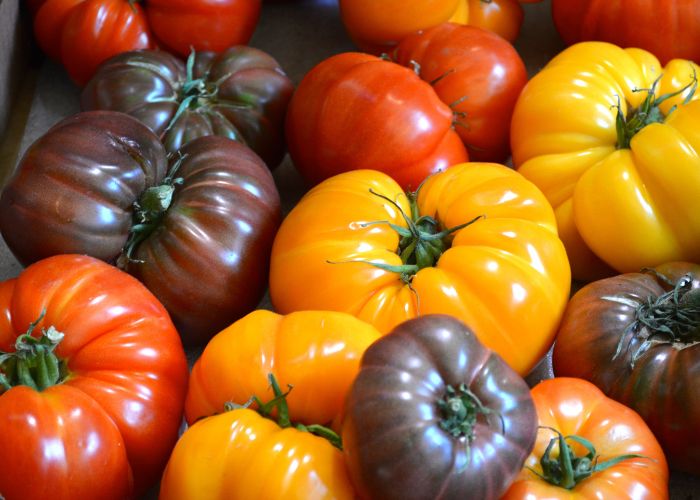MADRID – It has probably happened to you: you buy tomatoes and when you eat them the taste is bad. And that’s not just the case in the north. Complaints are also made about the quality of tomatoes in Spain today. But there are also positive developments.
No doubt you know them too: tomatoes that look beautiful but are as hard and have almost no taste. In the Netherlands, it has become like a game in the Netherlands to complain about their own tomatoes. Furthermore, often they refer to countries such as Spain or Italy, where tomatoes “still taste like they should”. However, this could not be less true. In Spain, too, it is now common practice to grumble at the table that the tomatoes taste “like cardboard”.
The supermarkets have done it
And the critics in Spain are right. As early as 2019, an article was published in the renowned scientific journal Nature Genetics, which showed that the varieties that dominate the tomato market worldwide are less tasty than rare varieties.
The reason? Tomatoes often have to travel far before they reach your supermarket. And then they still have to look nice. Commercial growers therefore mainly use varieties that can withstand rough handling, have a long life and have a bright red colour. But those are not necessarily the types that are also tasty. In addition, growers are paid per kilo, so it doesn’t pay to grow smaller, more tasty varieties.
Looking for older tomato varieties
Fortunately, there are also people in Spain who are trying to turn the tide. At the Madrid research institute for agriculture and food quality IMIDRA they conduct research into older, local varieties of well-known food crops.
In 2021, the institute was able to make three older tomato varieties suitable for large-scale cultivation again: the Moruno, the Gordo and the Antiguo. These three varieties were widely grown in the vicinity of Madrid until the 1960s, but they gradually fell into oblivion due to the migration from the countryside to the city. In collaboration with local farmers and the supermarket chain Alcampo, the Moruno, Gordo and Antiguo have been re-grown and are sold again in the Alcampo supermarkets in Madrid. The local restaurants also use them in their dishes.
Swap markets
Another development is underway in Andalucia. There, the Andalucian horticultural organisation HORTOAN organises exchange markets where commercial horticulturists and hobby gardeners can exchange seeds of older varieties with each other, without any commercial purpose. This does not only concern the seed of tomatoes, but also, for example, cucumbers and potatoes. This allows the participants to bypass the commercial seed trade. After all, this is mainly aimed at selling the seed of annual plants, with fruits that do well in the supermarket but also have less taste. The barter trade in older, non-annual seed varieties gives growers the opportunity to harvest their own seed from the previous year’s harvest. This way they can provide their own seed and keep older tomato varieties alive.
Related post: Seedbank in Andalucia brings old fruits and vegetables from oblivion
New technology
While organisations such as IMIDRA and HORTOAN look to the past for a solution, the Institute of Molecular and Cell Biology in Valencia mainly focuses on the future. International research has already mapped the DNA information of all tomato varieties in the world. This also makes it clear which chemical components in the tomato provide the taste.
With the new so-called CRISPR technology, the institute in Valencia has succeeded in adapting the DNA material of the tomato plant in such a way that the plant produces tasty tomatoes. It would then not be about genetic manipulation in the classical sense, but about imitating a process by which this mutation could also occur spontaneously in nature. However, the CRISPR technique is so new that governments worldwide are still investigating whether they want to legalise it or not. So it will be a while before we will find tasty CRISPR tomatoes in the supermarket.
Tips for home
And what can you do yourself in the meantime to ensure that your tomatoes are and remain tasty? Experts give two tips.
The first tip is simple:
- whatever tomatoes you buy, never keep them in the fridge. It has been scientifically proven that this does not improve the taste of tomatoes.
And second:
- when you buy tomatoes, think about what you want to use them for in advance. Regular supermarket tomatoes are fine for a sofrito or a gazpacho. Then the other ingredients will take care of the taste. But in a dish where the tomato stands alone, such as in a salad, it is better to use a good quality tomato. You can find it at the organic supermarket.
But the best tip is probably to just grow your tomatoes yourself. At least if you have the opportunity. And preferably a tomato variety that doesn’t taste like cardboard.
Related post: A box of tomatoes for 4,000 euros?


